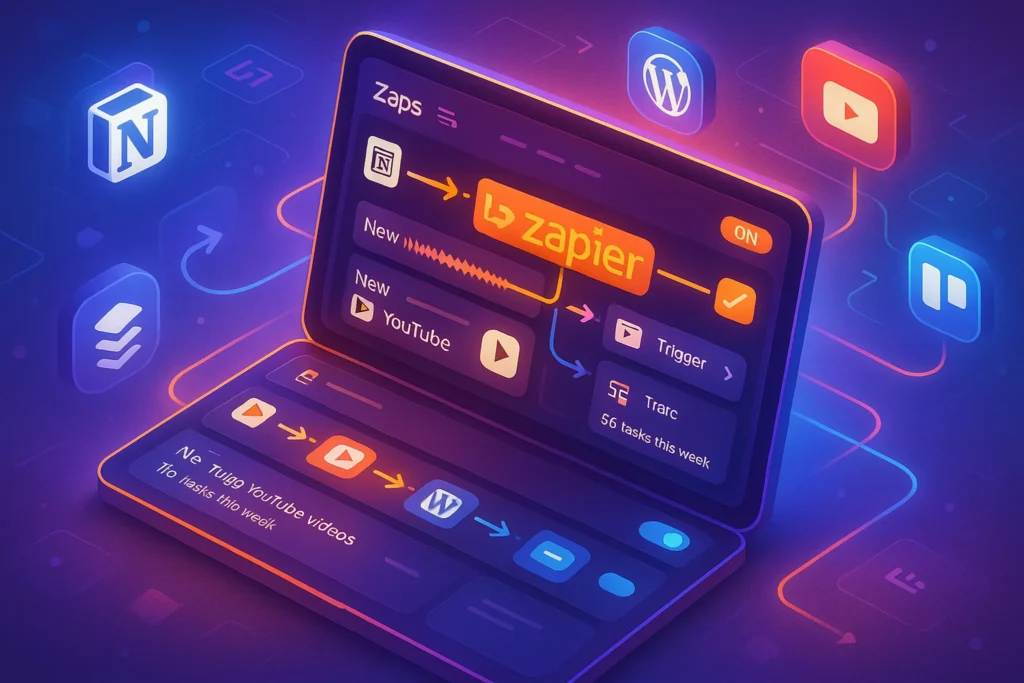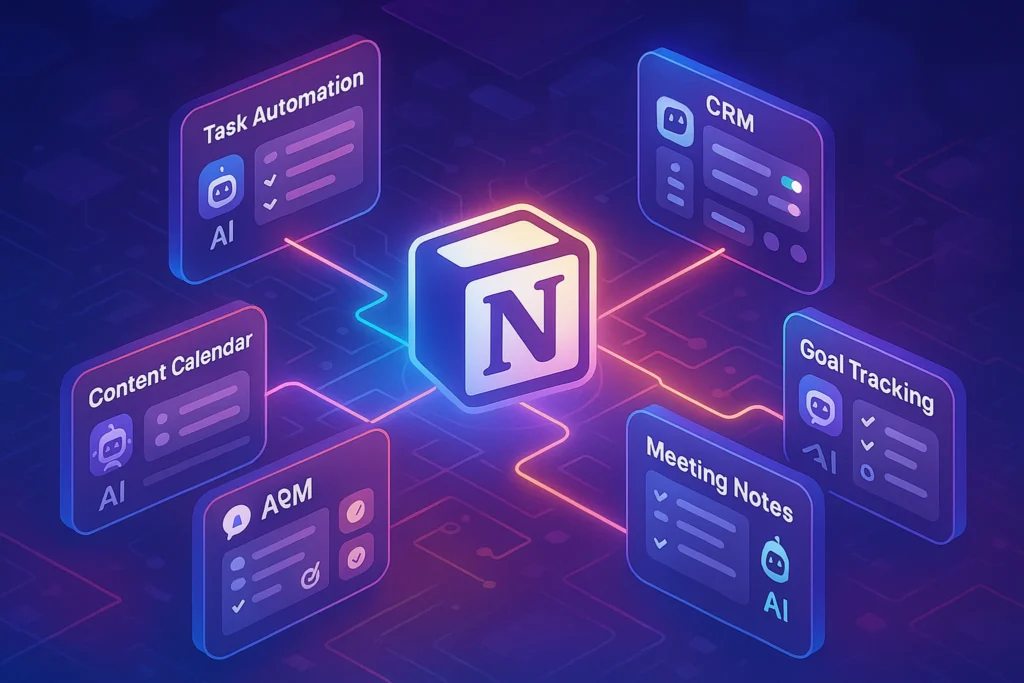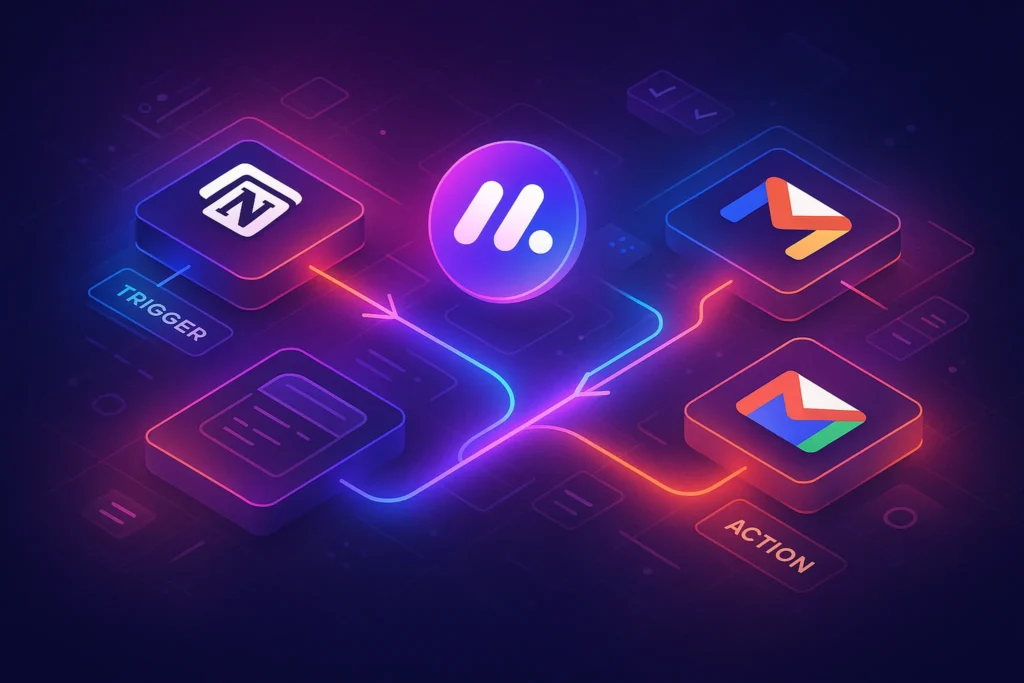-This post may contain affiliate links. If you click on one and make a purchase, I may earn a small commission at no extra cost to you.-
✨ Introduction – Automate So You Can Create
As a creator, your time is best spent ideating and creating—not duplicating tasks. Zapier offers no-code automation (“Zaps”) that connects hundreds of apps, letting you focus on what matters most. In this guide, you’ll discover key automations that handle publishing, audience engagement, content backup, and more—seamlessly.
🔌 Must-Have Zapier Automations for Creators
1. Draft to Publish: Notion → WordPress
Auto-create blog drafts: move a Notion card into “Ready” and let Zapier publish it to WordPress as a draft, complete with metadata and tags. Ideal for content teams and solo writers.
Real Use Case:
You draft in Notion, collaborate with guests, and when ready, move the card—you’re notified when the draft goes live, no manual export needed.
2. Social Snippet Scheduler: RSS → Buffer/Publer
Connect your blog’s RSS feed to Buffer or Publer to auto-schedule posts whenever new content is published. Add AI-generated captions, optimal hashtags, and timing.
Real Use Case:
Did you know using keyboard automations like sending Slack updates on new social posts is boosted by mastering shortcuts? Check out our Windows 11 shortcuts guide for tools that pair well with Zapier tasks.
3. Lead Capture via Typeform → MailerLite
Automate email subscription: a subscriber fills out your landing Typeform → Zapier adds them to MailerLite with tags based on their answers.
Real Use Case:
A course creator tags leads by interest—Zapier segments them into “Video Workflow”, “AI Tools”, or “Course Tools” lists, then sends tailored welcome emails automatically.
4. YouTube Upload → Trello / Asana
After publishing a YouTube video, Zapier creates a task in Trello or Asana with video URL, title, and a checklist (e.g., “Add to blog, Schedule Twitch clip”).
Real Use Case:
Removes the need to manually create follow-up tasks after publishing—your productivity tools stay in sync.
5. Social Mentions → Slack
Track your brand’s social mentions by sending Twitter or Instagram mentions into Slack channels—complete with user, post, and link. Enables real-time responses.
Real Use Case:
Creators can reply in seconds to shout-outs or questions, improving engagement without checking multiple platforms.
6. Zoom Recording → Google Drive + Otter.ai Transcript
After a Zoom session, Zapier automatically saves the recording to Drive and starts transcription via Otter.ai.
Real Use Case:
Perfect for panel recordings, repurposing Zoom calls into YouTube clips, blog transcripts, or course content—without manual uploads.
7. YouTube Comments → Google Sheets
Every new comment on your video is logged in Sheets—so you can analyze engagement, spot trends, and respond strategically.
Real Use Case:
One creator used this to identify frequent viewer questions and built FAQ videos in response, boosting audience loyalty.
8. Instagram Posts → Airtable Archive
Automatically archive every Instagram post and caption into Airtable, organizing your content library for repurposing.
Real Use Case:
Great for social-first brands that reuse old posts for email feeds, newsletters, or themed campaigns.
9. Podcast Episode → Twitter Thread Generator
When you publish a podcast RSS update, Zapier triggers ChatGPT to generate tweet thread bullet points, auto-publishes via Buffer.
Real Use Case:
Without lifting a finger, your podcast content spreads across platforms in bite size and drives traffic back to the full episode.
10. Form Documents via Docusign → Notion DB
Secure signing: when a contract is signed via Docusign, Zapier brings it into Notion with tags: “Client Name”, “Date Signed”, and link to PDF.
Real Use Case:
Perfect for freelancers working with NDAs, contracts—everything tracks automatically with no admin drag.
📈 Advanced & Creative Maker Automations
-
AI Sketch → Figma Update: After a new image is uploaded to a Dropbox folder, use AI to generate asset tags and create a Figma Frame.
-
Keyword Alert → Notion Journal: Get Slack alerts whenever Google Alerts finds a new mention of your keywords, automatically logged in Notion.
-
YouTube View Surge Alert: When a video reaches 10K views, launch a Slack alert with second-to-second breakdown and thumbnail link.
⚙️ How to Build Your First Zap
-
Choose your Trigger (e.g. “New YouTube Video”)
-
Define Actions (e.g. “Create Trello Card”)
-
Optional: Filters (e.g. only trigger videos tagged “Tutorial”)
-
Test the Zap.
-
Turn it on and automate your flow!
✅ Performance and ROI
-
Creators report saving 3–5 hours weekly using these automations.
-
Automating republishing across platforms can increase reach by 20–30% without extra work.
-
Organizing content and mentions boosts engagement and responsiveness—critical for community growth.
🎯 Bonus Automations for Niche Creators
a) YouTube Creators: Automate Clip Promotion to Telegram & Discord
After publishing a YouTube video, you can automatically extract a short teaser using Pictory or Kapwing. Zapier then posts that clip, with link and caption, to your Telegram or Discord audience.
Why it matters:
Active communities on these platforms love instant updates. Automating the process keeps them engaged without manual upload, maintaining channel buzz and driving traffic.
How to set it up:
-
Trigger: New YouTube video by you → action in Pictory or Kapwing to generate 30–60s clip.
-
Action: Upload clip as file to Telegram or Discord via Zapier integration.
-
Bonus: Add automation to pin the post or add a hashtag.
b) Course Sellers: Auto-add Students to CRM After Purchase
When someone buys your course (via Gumroad, Teachable, or Stripe), instantly tag them and add to your CRM or email tool (e.g., ActiveCampaign, ConvertKit).
Why it matters:
You can send tailored onboarding content, launch follow-up campaigns, or segment learners by module interest—all automatically.
Zap structure:
-
Trigger: New sale in Stripe/Gumroad → Action: Add subscriber in ActiveCampaign with tags like
Course A – Week 1. -
Bonus step: Send a Slack notification to your team with the student’s name and email.
c) Podcasters: Auto-Create Episode Show Notes in Notion
Each time a podcast episode is published (via RSS or new recording in Google Drive), use Zapier to create a template show‑notes page in Notion with fields for timestamps, guests, and topics.
Why it matters:
Keeps your publishing workflow consistent and organized. Your writing team knows exactly where to fill details and upload transcription, without hunting for files.
Zap structure:
-
Trigger: New MP3 file in Drive or RSS push
-
Action: Create Notion database entry with title, date, link, and empty show‑notes template.
🔁 Repurpose One Automation Across Multiple Scenarios
Designing a versatile Zap helps you scale efficiency across different content types and channels. Let’s walk through a smart adaptation:
Example Zap: “Content → Calendar Block”
Original Purpose:
A Zap for when you schedule a draft in Notion, it creates a calendar event in Google Calendar as a reminder.
How to Repurpose It
-
Instagram/Social Post Prompts:
-
Action 1: Create a draft in Notion
-
Action 2: Trigger a calendar block with “Publish to Instagram at HH:MM”
-
-
Podcast Workflow Integration:
-
Action 1: When Notion card moves to “Ready”
-
Action 2: Create Zoom recording date + calendar invite
-
Optional: Trigger email invite to co-host or guest
-
-
Affiliate Promotion Reminder:
-
Action 1: Notion card moved to “Published”
-
Action 2: Create calendar block 2 weeks later with task “Check affiliate link status”
-
-
Cross-Platform Video Upload Reminder:
-
Action 1: YouTube clip published
-
Action 2: Calendar invite to publish Reels + TikTok
-
Action 3: Slack alert via Zapier’s Slack integration
-
Why This Matters
-
Modularity: One core Zap adjusted with filters/tags can serve various scenarios.
-
Consistency: All content types follow a visual schedule—keeping you punctual and proactive.
-
Scalability: Save time by cloning and adjusting the same workflow rather than building new ones for each need.
Bonus
If you love keyboard flow and time-saving hacks, our post on “20 Windows 11 Keyboard Shortcuts That Will Seriously Boost Your Productivity” dives deep into improving speed—pair these with Zapier for ultimate efficiency.
❓ FAQs
Q: Are there limits or costs?
Zapier’s free plan lets you run 100 tasks/month. Paid plans start at $20/month for 750 tasks and premium apps.
Q: Will automations break if APIs update?
Occasionally. Zapier will notify you of broken Zaps—simply re-authenticate or adjust settings.
Q: Can I automate for multiple social accounts?
Yes—Zapier supports multiple app connections (Buffer, Publer, etc.) across team accounts.
🧠 Nerd Verdict
Zapier is a powerhouse for creators who want to automate repetitive tasks without code. Use it to schedule publications, repurpose content, manage leads, and track engagement—all so you can focus on creative work. These 10+ Zaps are ready to transform your workflow.
💬 Would You Bite?
Tell us: Which Zap are you implementing this week? Want template links or advanced configurations?
Drop a comment and toughen your no-code skills! 👇



